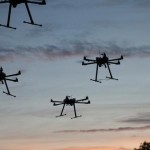 As drones have become more popular, there has been a greater emphasis on making them as safe as possible. For instance, a new social network called GoFlyZone, which uses the flight plans uploaded by drone operators to produce traffic maps, with the aim being to help avoid incidents by allowing other operators to see flight paths and times before they take to the sky.
As drones have become more popular, there has been a greater emphasis on making them as safe as possible. For instance, a new social network called GoFlyZone, which uses the flight plans uploaded by drone operators to produce traffic maps, with the aim being to help avoid incidents by allowing other operators to see flight paths and times before they take to the sky.
There are also improvements being made in the mapping capabilities of drones so that they can fly safely independently of an operator. A recent project saw the creation of detailed 3D maps for drones to navigate by.
Improving drone safety
A team from Stanford Intelligent Systems Laboratory (SISL) is working with NASA Ames to create a kind of traffic management system (UTM) for drones.
“UTM is meant to fulfill a lot of the functions of air traffic control, but it will be in the cloud and largely automated,” they say.
The aim is for the UTM to support the successful coordination of the huge number of drones currently operating without any kind of formal air traffic control. The new system will ultimately provide a form of automated conflict avoidance, alerting drones to potential conflicts in real time, giving them the appropriate instructions to avoid collisions.
The approach was documented in a recently published paper, where the conflict-avoidance algorithm is explained.
Scalable traffic control
The team believe that an automated approach to air traffic control is vital because the sheer number of drones in the air make replicating the human based approach is simply not scalable.
The Federal Aviation Administration currently has around 1 controller for every 6 pilot driven flights undertaken each day. It’s estimated however that drone flights could be double the volume of piloted flights just from Amazon Prime customers alone.
Add in all of the other possible users and you quickly appreciate that having human controllers is not feasible.
Roll out schedule
The plan is to roll the system out in four stages, with each stage seeing an increasing level of functionality and complexity built into the system.
The first stage has already been rolled out and offers users geo-fencing, which provides drones with corridors through which they can fly safely.
“That works for farming applications,” the team say. “But once you want to start moving transport drones around urban areas, you can’t really do that, because you’re not going to block out the airspace over entire residential areas just for when your aircraft is flying through.”
The team have a long history of working in this area, including on projects already being fed into the FAA’s ways of working, so there’s every reason to believe they have come up with a good solution here too.
Dealing with complexity
Of course, one added layer of complexity compared to traditional control systems is the sheer number of craft in the sky. In manned flights, conflicts between more than two craft are incredibly rare, but such events are altogether more common with drones.
“As the number of aircraft grows, the avoidance problem becomes exponentially more complicated, a challenge that mathematicians call the curse of dimensionality,” the team say. “So we have to come up with better ways than just brute-force searching and iterating through all possible solutions.”
The team overcome the problem by pairing drones up, with each pair then given the best and safest path to navigate, with a joint collision avoidance order then given to all drones in the danger zone.
The approach has been tested on over 1 million simulations, with potential encounters of up to 10 aircraft, and it frequently performed better than other solutions to the challenge.
Suffice to say, the system is not perfect and more work will need to be done to account for unpredictable events, whether that’s unusual weather, malignant drones or even communication breakdowns. Such evolution will be an ongoing process though.
Don't get me wrong, this is incredibly interesting, yet incredibly scary at the same time. Not sure I'd be ready to entrust such things to a machine (yet).
Avoid Bravo! Without a transponder aircraft TCAS still won't see them!